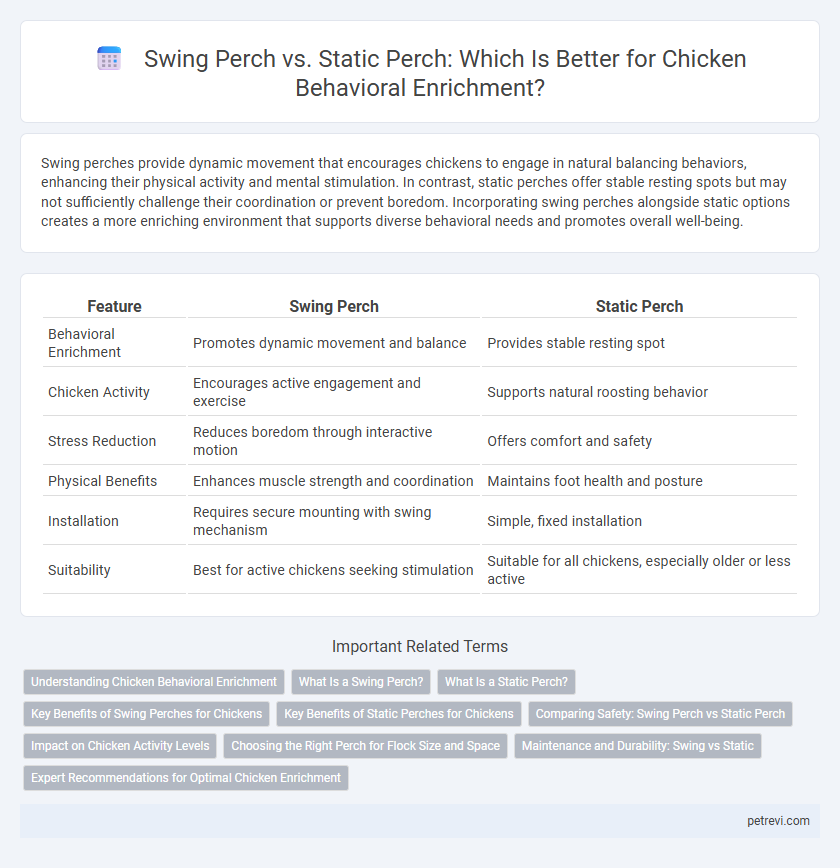Swing perches provide dynamic movement that encourages chickens to engage in natural balancing behaviors, enhancing their physical activity and mental stimulation. In contrast, static perches offer stable resting spots but may not sufficiently challenge their coordination or prevent boredom. Incorporating swing perches alongside static options creates a more enriching environment that supports diverse behavioral needs and promotes overall well-being.
Table of Comparison
| Feature | Swing Perch | Static Perch |
|---|---|---|
| Behavioral Enrichment | Promotes dynamic movement and balance | Provides stable resting spot |
| Chicken Activity | Encourages active engagement and exercise | Supports natural roosting behavior |
| Stress Reduction | Reduces boredom through interactive motion | Offers comfort and safety |
| Physical Benefits | Enhances muscle strength and coordination | Maintains foot health and posture |
| Installation | Requires secure mounting with swing mechanism | Simple, fixed installation |
| Suitability | Best for active chickens seeking stimulation | Suitable for all chickens, especially older or less active |
Understanding Chicken Behavioral Enrichment
Swing perches provide dynamic movement that stimulates chickens' natural instincts for balance and coordination, enhancing physical activity and mental engagement. Static perches offer stable resting spots essential for roosting behavior and social hierarchy establishment within flocks. Incorporating both perch types supports diverse behavioral enrichment by promoting exercise, reducing stress, and improving overall welfare in poultry environments.
What Is a Swing Perch?
A swing perch is a movable, suspended roost designed to enhance chicken behavioral enrichment by encouraging natural balancing and gripping activities. Unlike static perches, which are fixed and stationary, swing perches mimic the instability found in natural environments, promoting physical exercise and reducing stress. This dynamic movement stimulates chickens' coordination and mental engagement, contributing to improved welfare and overall health.
What Is a Static Perch?
A static perch is a fixed structure in a chicken coop that provides a stable resting place for chickens, typically made of wood or metal and securely attached to walls or supports. It serves as an essential element for natural roosting behavior, allowing chickens to sleep elevated from the ground, which enhances their comfort and safety. Static perches promote better foot health and reduce stress by mimicking natural roosting environments in the wild.
Key Benefits of Swing Perches for Chickens
Swing perches promote natural chicken behaviors by encouraging movement and exercise, enhancing muscle tone and joint health. They provide dynamic stimulation that reduces boredom and stress, leading to improved mental well-being. Compared to static perches, swing perches increase social interaction and help prevent feather pecking, supporting overall flock harmony.
Key Benefits of Static Perches for Chickens
Static perches provide chickens with a stable and secure resting place, reducing stress and promoting natural roosting behavior. These perches support bone strength and foot health by encouraging proper weight distribution and muscle development. Their fixed position allows chickens to establish consistent roosting routines, enhancing overall flock hierarchy and social stability.
Comparing Safety: Swing Perch vs Static Perch
Swing perches offer dynamic movement that can improve chickens' balance and exercise, but they may pose a higher risk of injury if birds lose stability or the perch swings excessively. Static perches provide a stable, immobile platform that reduces the likelihood of falls and injuries, making them generally safer for chickens, especially younger or less agile birds. Optimal safety is achieved by considering flock age and behavior while choosing perch types that minimize risk without compromising enrichment.
Impact on Chicken Activity Levels
Swing perches enhance chicken activity levels by encouraging movement and balance adjustments, which promote muscle development and reduce sedentary behavior. Static perches provide stable resting spots but may not stimulate as much physical activity or engagement. Studies show chickens with access to swing perches demonstrate increased locomotion and overall energy expenditure compared to those with only static perches.
Choosing the Right Perch for Flock Size and Space
Selecting the appropriate perch type for chickens depends on flock size and available space, as swing perches offer dynamic movement that encourages natural foraging behaviors, ideal for smaller flocks with ample room. Static perches provide stability and can accommodate larger groups by maximizing vertical space in compact areas, reducing crowding and territorial disputes. Balancing perch design with flock dynamics enhances welfare by promoting physical activity and social interaction.
Maintenance and Durability: Swing vs Static
Swing perches require frequent maintenance to ensure their moving parts remain functional and safe, as constant motion can lead to wear and loosening of attachments. Static perches offer superior durability due to their fixed nature, minimizing mechanical failures and reducing the need for repairs. Choosing static perches can lower long-term maintenance costs while providing a stable environment for chicken behavioral enrichment.
Expert Recommendations for Optimal Chicken Enrichment
Experts recommend swing perches for chickens to enhance natural behaviors, promoting better physical activity and mental stimulation compared to static perches. Swing perches mimic natural branch movement, encouraging balance and reducing stress, which leads to improved overall health and reduced aggression in flocks. Incorporating both swing and static perches creates a diversified environment that supports varied perching preferences and optimizes behavioral enrichment.
Swing Perch vs Static Perch for Chicken Behavioral Enrichment Infographic

 petrevi.com
petrevi.com